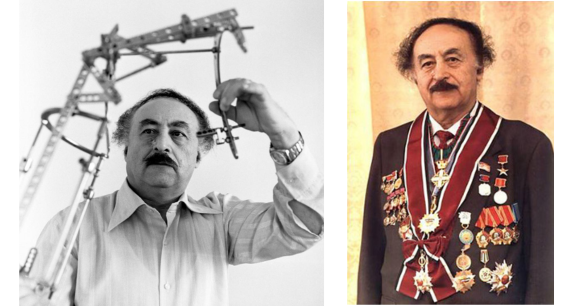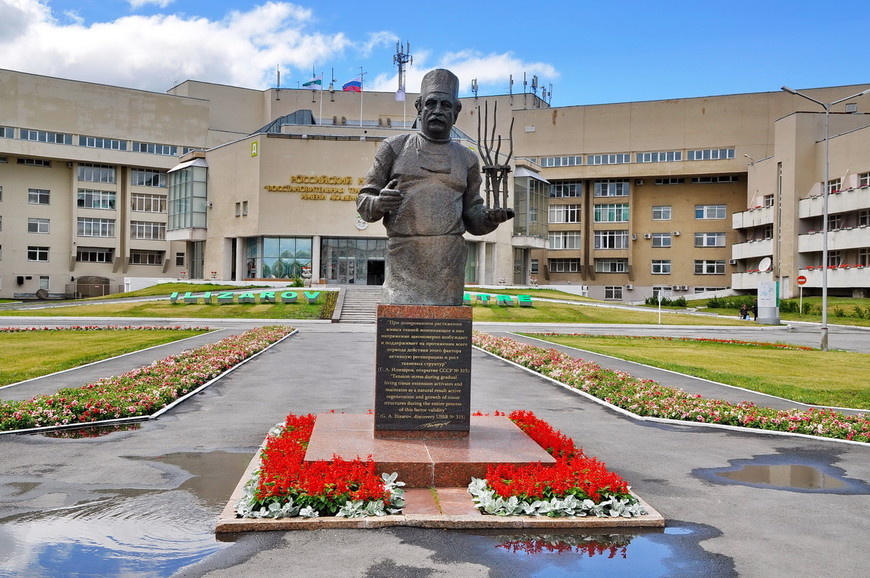The Michelangelo of Orthopedics
Гавриль Абрамович Ильзаров (1921-1992) was a Russian orthopedic surgeon whose groundbreaking work in the field of bone and joint surgery has left an indelible mark on the orthopedic world. Most notably, he is celebrated for developing the Ilizarov External Fixator, a revolutionary device that has transformed the way bone fractures, deformities, and length discrepancies are treated. His innovations not only changed surgical approaches but also saved lives, improved outcomes for patients, and paved the way for further advances in orthopedic care.

Unlike many orthopedic pioneers in developed Western countries, the success of Gavriil Abramovich Ilizarov, the founder of the circular external fixator, has gone through an extremely difficult and tortuous road.
In June 1921, Ilizarov was born in a poor family in the Caucasus of the former Soviet Union. His parents were illiterate, and there were six children. This meant that Ilizarov had no chance to go to elementary school until he was 11 years old. But he completed 8 years of compulsory education in a relatively short period of time, and his grades were always among the best.
In 1939, he began to study medicine at the Crimean Medical College. But as the Soviet Union was involved in World War II in 1941, students were forced to evacuate. He could only continue his studies at the Medical College in Kazakhstan. After graduating in 1944, he was assigned to work in Kurgan, a remote area in western Siberia, where he spent his entire life.
His career began like this. The so-called hospital was just a few wooden houses, and he needed to burn a fire to keep warm to survive the long winter in Siberia. The area where he was located was as large as the entire country of Belgium, but he was the only doctor. It was at this time that he began to come into contact with many patients with lower limb injuries and deformities caused by war injuries.
The simple plaster fixation was disappointing, and Ilizarov thought: There must be a better treatment method. He started with a semi-circular frame and a Steinmann pin, but soon found that two semi-circular frames could be screwed together to form a full-circular external fixator.
In fact, a similar circular external fixator had appeared as early as 1934, and the inventor was American Joseph E. Bittner. But at that time, the external fixator was only used as a fracture reduction device, and the plaster had to be removed after it was applied. There are such treatment methods in the United States and Germany. The understanding of this type of external fixator in the Soviet Union is generally believed to have come from Germany during World War II. Of course, what really made Ilizarov successful was not the external fixator itself, but the theory of external fixator treatment he proposed through years of experiments and clinical observations. The core of the theory is: continuous traction will stimulate bone growth. Under the guidance of this theory, trauma orthopedics, delayed fracture healing, nonunion of fractures, limb lengthening, etc. can all be treated with external fixators.
Interestingly, Илизаров жоғарыда аталған құбылыстың сәттілікке байланысты екенін білді. Бірде ол демалыста болды, Сый емес науқас ауруханаға келді. Медбике сынықтардың қысымын жоғарылатқысы келді, оларды жақсырақ байланыстыру үшін аяқталады, Сондықтан ол сыртқы бекітушіні түзеткен. Күтпеген жерден, ол түзету бұрандасының бұрылыс бағытын дұрыс қабылдады. Бірге жақын болудың орнына, Сынық бөлінгенді аяқтайды. Бірақ кейінірек X-RATAS сүйек қоңырауы өскенін көрсетті. Бұл Ильзаровтың назарын аударды.
Тағы бір уақыт, Тізеден төмен ампутацияланған науқас дәрігерге келді және протезді киюге болатындай етіп, тізе бүктелудің қандай-да бір жолдары бар ма?. Илизаров оған алдымен сыртқы тірек орната алатынын айтты, сүйекті кесіңіз, және ұштарын ажыратыңыз. Кейін 4-5 айлар, bone grafting was performed between the ends. But after a few months, the patient did not come back to see the doctor. Half a year later, Ilizarov met the patient by chance. The osteotomy site had completely healed, the stump had become longer, and no bone grafting was needed.
In this way, in the early 1950s, Ilizarov perfected the theoretical basis and practical application of his external fixator, but it was unknown to outsiders.
It is said that in 1951, he went to Moscow to demonstrate his theory and external fixator. But the official condition was that the name of the president of the Central Research Institute of Traumatology and Orthopedics should be attached before the patent could be granted. Ilizarov refused and returned to Siberia to work quietly.
This went on for more than 10 years. Технология әлдеқайда жетілген сайын және одан да көп пациенттер емделді, Мәскеудегі Кеңес Денсаулық сақтау министрлігіне хабарланатын жаңалық.
In 1965, Ресми Лорековскийді Қорғанға тергеу үшін жіберді. Жартылай зейнеткерлік дәрігер ұзақ уақыт бойы Ильзаров Лунатикалық және билік өз жетістіктерін алаяқтық ретінде қарастырғанын естіді, Оның тергеудің мақсаты Ильзаровқа қарсы дәлелдер жинады. Дегенмен, оның инстинктерімен және білімімен дәрігер ретінде, Ол Сібірдегі ауруханаға келген кезде ол жерде кезектен тыс нәрсе бар екенін сезінді. Осы шалғай ауруханадағы жағдайлар өте қиын болды, және жұмыс өте жақсы болды. Горековский Мәскеуге оралғаннан кейін шындықты хабарлады, Бірақ билік оған сенбеді, Бірақ оны демалдырды. Of course, Денсаулық сақтау бөліміндегі халыққа саңырау құлағы илизаровтың технологиясын жалғастыру оңай болған жоқ.
Біреу Кеңес өкіметіне жазды, Ильзаровтың ауруларды емдеу әдісін сұрау. Билік Денсаулық сақтау министрлігінен Мәскеуде осындай технология болған жоқ па деп сұрады, Денсаулық сақтау министрлігі иә деп айтуы керек еді. Of course, Ilizarov, Кім мыңдаған миль қашықтықта болды, шақыру мүмкін болмады, Сондықтан Горековский мұны істеуі керек еді. Илизаров өзінің билікпен жұмыс істемейтініне сенімді болды, Осылайша, Кеңес Оқиғасы бөлімі оған қиын болды. Ол Сібірдің шалғай бұрышында тұрды. Бір жағынан қарағанда, Әрине, бұл оның бақытсыздығы, бұл оның идеялары мен әдістеріне әлемнің өзі қабылдағаннан кедергі келтірді; басқа жақтан, Оның сәттілігі де болды. Өйткені, Ол ресми араласудан алыста болды және оның медициналық емдеумен және зерттеулерімен салыстырмалы түрде тыныштықпен айналыса алды.
In 1967, әлі де кездейсоқ, Илизаров түні бойы танымал болды, өйткені ол Onteomileititis және Остеомиелит пен Оймес емес, олимпиадалық жоғары секіруден өтті. Содан бері, Оған пациенттер кірді. Оқу құралдары мен оқу-әдістемелік материалдар арқылы, Оның техникасы барлық Кеңес Одағында тарады. Сол кезде, Бұл қырғи қабақ соғыс дәуірінде болды, Батыста Ильзаровтың не істеп жатқанын түсінуге мүмкіндігі жоқ, Ильзаров Куба бойынша операциялар жасаған болса да, бұл Флоридадан жүз миллиондаған шақырым жерде болды.
Илизаровтың технологиясы батысқа қарай таралғаны әлі де кездейсоқ болды. In 1980, Итальяндық зерттеуші кемеде жүзіп, жұқтырған тибиальды псевдоартрозды жасады. The doctor on the ship happened to be a Soviet, and he immediately suggested that he see Ilizarov. When the explorer returned to Italy six months later, Italian doctors were surprised by the unexpectedly good recovery.
This year, Ilizarov set foot on Italian soil. This was the first time he showed his achievements in the Western world. He gave four reports, each lasting two hours. The audience watched those incredible cases with bated breath. The Italians immediately decided to establish the Ilizarov Method Research and Application Association. The Italian media even exaggeratedly called this technology “the second revolution in Russia” and praised Ilizarov as “the Michelangelo of orthopedics.”
In 1987, Frankel and Green became the first American doctors to visit Ilizarov in Siberia. They saw the “Russian Ilizarov Trauma and Orthopedic Reconstruction Science Center”, one of the largest and best trauma orthopedic hospitals in the world.
In his later years, Ilizarov was burdened by his success. He usually saw patients until 2 or 3 in the morning, and patients from all over the country stayed in front of his office for a long time. It was clear that he cared about every patient, but at the same time he could not bear such high intensity work for a long time. There was a back door in his office, and sometimes he slipped out through it.
Before his death, Ilizarov was already a household name in the former Soviet Union, with novels, plays and movies based on him. He also won almost all the highest honors of the country, including the Order of Lenin.

Leading Suppliers of Ilizarov External Fixation
Today, many companies provide external fixators inspired by Ilizarov’s work. These companies offer advanced versions of the original apparatus, improving upon the design and functionality to meet the needs of modern orthopedic care. Here are a few of the prominent suppliers in the field of external fixation.
1.Orthofix Medical Inc.
A global leader in orthopedic devices, offering advanced external fixation systems for limb reconstruction and deformity correction.
2.Smith & Nephew
Provides innovative external fixation solutions, including circular frames for complex orthopedic cases.
3.DePuy Synthes (Johnson & Johnson)
Offers a range of external fixation devices, including modular systems for trauma and limb lengthening.
4.Stryker
Known for its comprehensive orthopedic solutions, including external fixators for fracture management and bone regeneration.
5.Russian Ilizarov Scientific Center
The original institution founded by Ilizarov, continuing to produce and distribute the authentic Ilizarov apparatus.
6.Biomet (Zimmer Biomet)
Provides external fixation devices designed for the stabilization and treatment of fractures. Their products are known for innovation and ease of use in clinical settings.
Conclusion: Legacy of Gavriil Ilizarov
Gavriil Abramovich Ilizarov’s contributions laid the foundation for the development of modern techniques in limb lengthening, bone reconstruction, and deformity correction, influencing the practices of orthopedic surgeons worldwide.His pioneering development of the external fixator system laid the groundwork for future advances in the field, Оның мұрасы көптеген ортопедиялық хирургтар мен олардың техникасы бойынша асырап алған компаниялар арқылы жалғасады.
Ортопедиялық мамандар үшін, Ильзаровтың инновацияларының тарихын түсіну қазіргі заманғы ортопедиялық әдістердің эволюциясын бағалау үшін ғана маңызды емес, Сонымен қатар, пациенттердің күтімі мен нәтижелерін жақсартуды жалғастыратын айтарлықтай жетістіктерді тану үшін. Жетекші компаниялардың алдыңғы қатарлы сыртқы тіректерінің қол жетімділігі Ильзаровтың клиникалық тәжірибесінде қолданылуын қамтамасыз етеді, дәл және тиімділігі бар ең күрделі жағдайларды емдеу үшін қажетті құралдармен ортопедиялық хирургтармен қамтамасыз ету.
Ортопедия саласы дамып келе жатқандықтан, Ilizarov-дің жарналары «Аппараттық» болып қалады, Дүние жүзіндегі сансыз науқастарға үміт пен жақсартылған нәтижелер ұсынады.
Ескерту:Авторлық құқық түпнұсқа авторға және журналға тиесілі,Хабарламалар тек оқуға және байланысқа арналған.